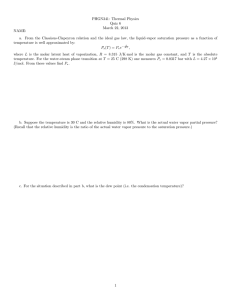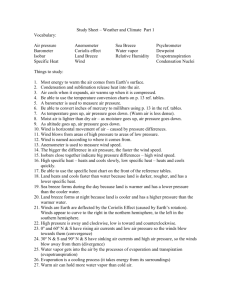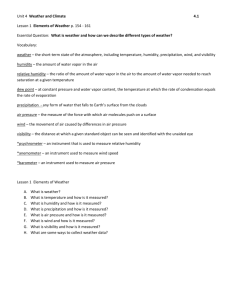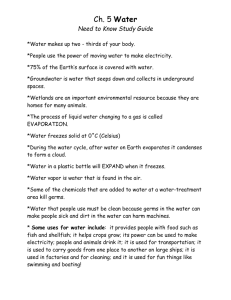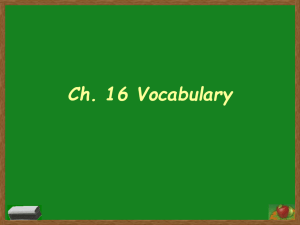tea S ,D 43_3 FOREST PRODUCTS LABORATOR Y
advertisement
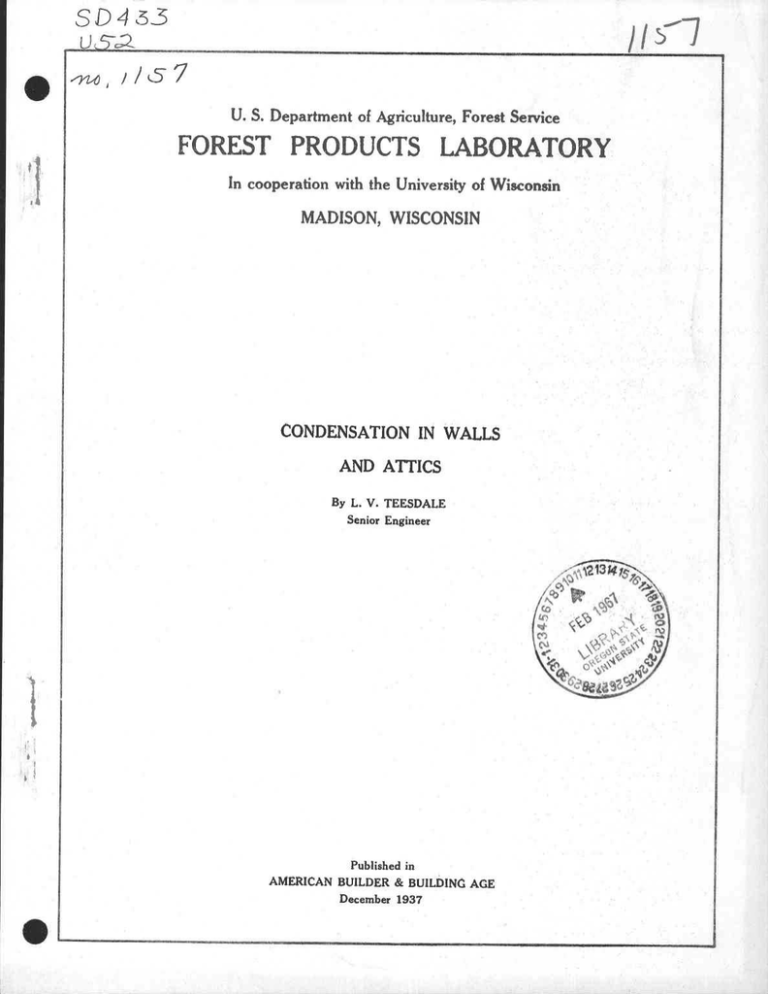
S ,D 43_3 tea ; /5"7 U. S . Department of Agriculture, Forest S ice ' FOREST PRODUCTS LABORATOR Y In cooperation with the University of Wiscsiu .. MADISON, WISCONSIN : 1 1 Id( CONDENSATION IN WALL S AND ATTIC S By L . V . TEESDALE Senior Engineer Published i n AMERICAN BUILDER & BUILDING AC E December 1937 a - S CONDENSATION IN WALLS AND ATTIC S By L . V . TEESDALE , Senior Enginee r Condensation or moisture accumulation within walls and in attic s or roof spaces has become a subject of considerable concern to many hom e owners and prospective builders, especially in the states north of the Ohi O River . This problem is not new ; it has been known for many years that con densation occurs under certain conditions in houses and barns, particularl y in localities subject to severe winter weather,but only recently has it be come a general problem, particularly in the better class of construction . There have been so many cases in recent years that any prospective builde r may hear about ice in attics, stained ceilings and side walls, plaster be coming loose, ruined decorations, decayed side wall, roof, studs, an d sheathing, floors that have bulged up, outside paint failures, and numerou s other manifestations of moisture resulting from condensation . While no doub t there is some , exaggeration as to the extent of damage, there is also muc h truth . Such instances of damage have been occurring frequently in the las t In some instance s few years, particularly after the cold winter of 1935-36 . the damage is visible,whereas in others it is concealed in the walls an d unknown . Even new houses under construction in cold weather often sho w evidence of moisture, especially if plastered during the late fall or winte r months . Obviously the question arises as to why we hear so much more abou t this condition now than we used to just a few years ago . The answer is relatively simple . During the last few years there has been a marked tendency o n the peat of the architects, builders, and home owners to improve homes bot h new and old with the idea of increasing the comfort of the occupants and de creasing operating expenses . Prominent among these improvements are th e increasing use of storm sash, insulation, weather strips, calking aroun d windows and doors, and other means of decreasing heat loss and wind infiltration . Because of the tighter construction the normal humidity or vapo r pressure within a house so constructed is higher than in houses less tightl y constructed . In addition, as a health and comfort measure the normal humidit y is usually augmented by evaporating water or some other means of winter ai r conditioning . Improvements that add to comfort and health are worth whil e and should not be discouraged,but it so happens that they introduce th e unanticipa.ted moisture problem Juet - de-eari .bed . - • A certain amount of water vapor is always present in the atmosphere . The maximum amount of water vapor that can be present depends upo n the temperature of the air, being greater at higher temperatures . Air tha t is completely saturated with water vapor is said to be at its dewpoin t temperature and its relative humidity is 100 percent . Air not completel y saturated with water vapor is above its dewpoint temperature and its relativ e humidity is less than 100 percent . Adding water vapor to unsaturated ai r without changing the temperature of the air will increase the relativ e humidity and raise the dewpoint temperature . Removing water vapor will hav e the opposite effects . Raising the temperature of air without changing th e amount of water vapor in it will decrease its relative humidity . Lowerin g the temperature will increase the relative humidity till the dewpoint temperature is reached . Further lowering will cause progressive condensatio n of water vapor from the air . The use of relative humidity as a measure of the amount of wate r vapor present in a given atmosphere is not satisfactory because this relationship varies with the temperature . Hence it is more practical to us e the vapor pressure of the water vapor for this purpose, since it is a direc t measure of the proportion of vapor present in the air . This property i s usually expressed ig terms of inches of mercury . At zero degrees R. air will hold very little water vapor . I f saturated air from out of doors at zero degrees temperature is introduce d without adding roisture into a house heated at 70° F ., the relative humidit y will be about 5 percent . However, there are sources of moisture within a n occupied house, such as cooking, evaporation from plants, laundry work , respiration, and bathing, so that the normal relative humidity within a hom e may be about 10 to 15 percent when the outdoor temperature is zero . Evaporation from a furnace pan or water pans on radiators may increase the humidit y to 20 percent or more . This means, of course, that the vapor pressure insid e of the home will be higher than that outside . Because of the higher wate r vapor pressure within doors there will be a constant out leakage of wate r vapor, the amount depending upon the tightness of windows and doors, the permeability of the wall materials, and upon other factors . If doors and windows are loose, water vapor will pass out readily and if tight the leakag e will be minimized . Winter air conditioning means, among other things, maintaining a humidity in the home at some established value intended to be better suite d to health, comfort, and protection of woodwork than the normal humidity jus t described . With winter air conditioning the relative humidity may often b e 40 percent or higher . The humidity may be controlled automatically wit h nygrostat, in which case it will be relatively constant, but without suc h control the humidity may fluctuate considerably . The effect of the humidity or vapor pressure on condensation ca n be understood 'by exaai .ning figures 1 and 2 . Figure 1 illustrates a typica l frame wall of lath and plastery studs, sheathing, sheathing paper, and woo d siding. Figure 2 illustrates a wall similar in all respects except that th e • '-81157 -2- 411 stud space is filled with insulation . For purposes of illustration th e following examples have been chosen : One indoor temperature of 70° F . ; thre e outdoor temperatures of 20° F ., 0° F ., and -20° F . ; and three indoor relativ e humidities of 140 percent, 30 percent, and 20 percent . When the temperatur e of the room side of the sheathing is above the dewpoint temperature in th e room no condensation can take place within the stud space . When, however , the sheathing temperature falls below the room dewpoint a different set o f conditions prevails . If, in figure 1, the lath and plaster offered no resistance to the passage of vapor, condensation could take place on th e sheathing with the latter exactly at the room dewpoint . The amount o f condensation would be limited only by the ability of the sheathing t o function as a condenser and the permeability of the sheathing to wate r vapor . Since the lath and plaster do offer some resistance to the passag e of vapor, the vapor pressure within the stud space will be less than tha t within the room whenever there is vapor movement through the lath and plaster . Actually, therefore, condensation cannot take place within the stud spac e until the sheathing temperature is appreciably less than the room dewpoint . When condensation is actually taking place on the sheathing, the vapo r pressure within the stud space will be largely determineu by the sheathin g temperature and will, in general, correspond rather closely to saturatio n pressure at this temperature . The three jagged lines marked "temperature " show the temperature gradients from one side of the wall to the other fo r the three chosen conditions . The three dashed horizontal lines marke d "dewpoint temperature" serve to locate the dewpoint temperatures for th e foregoing three indoor relative humidities . The water vapor pressure s corresponding to these dewpoints are also marked on the respective lines . Comparing figures 1 and 2, it is at once evident that, within th e stud space, the temperature gradients are much steeper in figure 2 than i n figure 1, and that the respective sheathing temperatures are much lower i n figure 2 than in figure 1 . This results from the addition of insulation i n figure 2 . Because of the lower sheathing temperatures condensation wil l occur on the sheathing with lower room humidities when insulation is use d than when it is not used . Conditions within the walls are actually mor e complicated than the drawings and examples indicate, because they are no t static, and matters of heat balance and rates of water vapor movement an d air movement have important effects upon what goes on . Referring again to figure 1 : When the relative humidity withi n the house is 40 percent the vapor pressure is approximately 0 .295 of an inch . The temperature gradient through the wall when the outside temperature i s 20° below zero intersects the room side of the sheathing at about 26° abov e zero and,assuming saturated air at this point, the vapor pressure there wil l be only about 0 .137 of an inch . This difference in vapor pressure will caus e vapor to move from the room through the plaster to the stud space and condensation will develop in this space . This condensation will eventuall y appear as frost or ice on the sheathing, which is below the freezing point . The still lower temperatureand 'epos--pressure on the inner face of th e sheathing paper will cause some of the remaining moisture vapor to move fro m the inside face of the sheathing to the colder face of the paper but as th e P1157. • resistance to such movement is greater through the sheathing than throug h the open stud space the rate of vapor movement will be correspondingly small . However, with a rise in outside temperature the ice may melt and some wate r may be absorbed by the sheathing . Some may even run down inside the wall . The better grades of sheathing paper commonly used are very vapor resistan t and very little vapor will pass through, but with changing outdoor temperatures when cold weather is followed by mild temperature the ice that form s between the sheathing and the paper may melt behind the paper, run down t o a horizontal joint where some may work through and wet the siding . This i s one source of moisture that may contribute to paint failures . The same general principle of vapor movement exists where fil l insulation is used . The insulation 'itself is not resistant to vapor movement and the bulk of the condensation appears on the inside face of th e sheathing . However, in the insulated wall the resistance to heat loss offere d by the insulation results in a much lower temperature at the sheathing line , consequently the sheathing is below the dewpoint temperature at much highe r outside temperatures than is the case in uninsulated walls . This fact i n turn very greatly increases the amount of condensation twat may collect,sinc e periods of extremely cold weather, such as are required to cau- e condensatio n in uninsulated walls, are of relatively short duration b .t there may oe a total of several weeks during the winter when the outside temperature is lo w enough to cause condensation in insulated walls . There are a number of types and kinds of insulation on the marke t and the potential buyer often hears that certain types ' : draw water" an d become wet This is not true . Such insulation, because of ite efficienc y in reducing heat loss, lowers the temperatures within the wall and thus set s up the condition that increases the amount of moisture that may accumulate . Once understanding the conditions that cause the moisture it is also possibl e to provide means of prevention as discussed later . The conditions that cause condensation in side walls also occur i n attics or under roofs, modified more or less by any ventilation that may b e provided or that may occur naturally . Roof condensation is reported far more frequently than side wall condensation, not necessarily because it occur s more frequently but rather because it is more likely to be seen by the oocupants . For example, in a pitched roof house Navin ;;, say, fill insulation in the ceiling below the attic, condensation may develop during a severe col d spell on the under side of the roof boards, forming as ice or frost . Whe n the weather moderates, or even under a bright sun, the ice melts and drip s on the attic floor, leaks through and spots the ceiling below . Often suc h spots are asea,ned to be roof leaks and cause owners and contractors considerable unnecessary expense in attempting to waterproof a roof that is no t leaking . If Lhe attic has adequate ventilation little or no trouble wil l occur but adequate ventilation is sometimes difficult to attain, and tends t o -"lsaaa ©e -t la a- heat loss . R1157 • The movement of water vapor is independent of air movement to th e degree that no general circulation of air is necessary to carry the vapor int o the wall . The vapor actually moves by diffusion from zones of higher vapo r pressure to zones of lower vapor pressure . In fact plaster is very highl y resistant to air infiltration even when under a pressure equivalent to a win d velocity of 15 miles per hour but no such pressure exists within a house . Vapor, however, will move very readily through plain plaster but is retarde d somewhat by paint coatings and other surface treatments . Other types of wal l surfacing materials, such as plywood, fiber boards, and plaster boards ar e also permeable to vapor and here again the surface decorating material has mor e or less effect on the resistance . In the case of plywood the type of glue use d is also a factor, the phenolic resin glues being much more resistant than so y bean and casein glues to the passage of vapor . Moisture accumulation within a wall like those illustrated i n figures 1 and 2 is affected by five factors : 1. 2. 3. 4+ . 5. Outside temperature and humidity , Efficiency of insulation . Inside atmosphere (temperature and humidity) . Resistance of outer wall to vapor movement , Resistance of inside wall to vapor movement . As the outside temperature and humidity cannot be controlled and a s insulation adds to comfort, health, and fuel economy, me t hods of preventio n are limited to the three other factors . Some authorities believe that indoo r humidities low enough to preclude the possibility of moi :-tore accumulation ar e undesirable both as a factor of health and comfort and in preventing the over drying of interior woodwork and furniture, It is possible, of course, t o compromise and carry somewhat lower humidities during very cold weather tha n are maintained during moderate winter weather and thus reduce the amount o f moisture that would accumulate as condensation . It is also possible to s o construct walls that the vapor could pass outward through sheathing and sheathin g paper and escape through openings in the outside wall covering or be carrie d away by ventilating the space between the sheathing and outside finish, Standard construction does not lend itself to this method of moisture elimination . Either the inclusion of ventilating holes in the side wall material or a ventilating space would require more or less modification of the conventiona l construction . One possible method for wood siding would be to place 1 by 2 inch furring strips over the sheathing, thus obtaining a vertical ventilatin g space approximately of 3/ 14 of an inch which should be open to the outside a t both the bottom and top of the wall so that air could enter at the bottom an d pass out at the top . The openings could be concealed behind but not covere d by mouldings or other treatment at the water table and cornice . Simila r ventilation could be adapted to stucco, brick, and stone exteriors . With thi s method the sheathing paper should be of a type that passes water vapor readily , such as slaters felt . During periods of protracted cold weather it is quit e possible that moisture would accumulate in the wall faster than it could pas s through and be removed by ventilation, hence the ventilation method might no t ssure complete protection . So far, the possibilities in this method have no t een thcrrorh1y . investigated by the Forest Products Laboratory . r 0 ell...1157 Attics under pitched roofs can often be ventilated either throug h windows or louvered openings, ventilators in the roof, or openings in chimneys . Wood shingle roofs when laid on roof boards that are separated abou t 2 inches will often allow enough ventilation in the attic to eliminate th e moisture problem . Flat roofs are more of a problem . Where the ceilin g joists or supports and roof joists or supports are separated enough to allo w a free circulation of air, and where sufficient openings and vents are in stalled a fair degree of ventilation can be obtained . Often the space unde r flat roofs is not sufficient to obtain adequate circulation . f- s The most positive, and least expensive, method of control so fa r experimented with at the Forest Products Laboratory is the use of vapo r resistant barriers at or near the inner face of the wall and under ceilin g joists under the attic . In houses under construction this barrier can b e attached to the inner face of the studs after the walls have been insulate d and before lathing or finishing the wall on the inside . In houses already plastered the barrier can be some suitable material or treatment applied t o the interior surface of exterior walls . While it might appear on firs t thought that such a barrier should be 100 percent resistant, actually , however, it is not practical to obtain 100 percent efficiency . With a suitable barrier, however, the amount of moisture entering the wall is s o small that it will not raise the moisture content to a degree that i s objectionable . The Forest Products Laboratory has been making tests on the vapo r resistance of various materials used in wall constructi n and also on man y , materials that might be used for moisture barriers . Although these test s are still under way and have not covered all possible materials, enoug h information is available to permit the selection of a number of material s that are highly resistant to the passage of water vapor . Among these ar e (1) asphalt impregnated and surface coated sheathing paper, glossy surfaced , weighing 35 to 50 pounds per roll of 500 square feet ; (2) laminated sheathin g paper made of two or more sheets of kraft paper cemented together wit h asphalt ; (3) double-faced reflective insulation mounted on paper . The watervapor resistances of these three materials, as measured at the Laborator y differ considerably one from another . Unfortunately, the work has no t progressed far enough yet to enable a definite statement of the precis e degree of vapor-resistance required for any specific set of conditions . Most of the discussions and recommendations in this preliminary article ar e based upon a climate such as that of Madison, Wis ., and upon plastered woo d construction . The recommendations have not yet been subjected to actual service tests, and may have to be modified as time goes on . The barrier when located as described on the warm side of th e deepoint position resists the passage of moisture while it is in the form o f vapor and therefore before it has a chance to condense into water . Henc e there is no hazard of water forming behind the plaster or other interio r wall finish . The barrier also prevents moisture from getting into the wal l `or attic space during the construction period, particularly during th e -plastering operation . O Such vapor barriers should be applied vertically on side wall s with edges lapping on the studs after the insulation is installed and befor e lathing . Horizontal joints should be made only where backed up with a plat e or header . The barrier should 'ae brought up tight against electric fixtur e outlets, air registers, door and window frames, and other similar openings . If wood lath, metal lath, or other types requiring a plaster key are use d the paper should be applied slightly loose so that the plaster can push th e barrier back to form the key . Where the ceilings below the attic or roo f are insulated the barrier should be applied in a similar manner . Walls finished with such materials as plywood, fiber board, plaste r board, and the like, should also have the barrier as described . Sheathin g paper when used outside of the sheathing in combination with the moistur e barriers described should be water resistant but not very vapor resistan t so that the small amount of water vapor that may leak through the barrie r can escape outward . Slaters felt meets this requirement . Quite possibl y the sheathing paper could be omitted entirely ; and it is conceivable tha t the omission would actually result in a drier wall . Further experiment s will have to be made before this point can be definitely settled . Somtm kinds of mineral wool are relatively resistant to wate r absorption, others are treated to make them resistant to wetting by water . This property, while desirable, does not make these maierials resistant t o the passage of vapor . Therefore they should not be considered a source o f protection against condensation . Some types of mineral wool have a vapor-resistant paper bac k attached to the batt . Tests to date indicate that none of these papers ha s a vapor resistance equal that of the 50-pound sheathing paper previousl y mentioned . They are sufficiently resistant, however, to be of definit e help in keeping the insulation and the wall dry and to warrant proper car e in installation . The wool batt is made to fit between standard stud, joist , and rafter spacing with tabs on the paper which extend out from the batt an d are tacked to the studs or rafters . The batt may be cut or forced back t o obtain the tabs at the end of the batt . Where the spaces are not standar d between studs, such as occurs around windows, dvrs, and dormers, particula r care should be taken to obtain good joints even if it is necessary to us e one of the barriers previously described . Blanket types of insulation are also available where the insulatio n is enclosed within a heavy paper covering treated with asphalt . This pape r covering is a fairly effective vapor barrier but not so effective as th e 50-pound sheathing paper . It is important that this type of insulation b e carefully installed so that vapor cannot work through around the edges . Th e tabs should be nailed to the face of the studs with the insulation loopin g loosely inward away from the inner face of the wall or if installed between studs it should be fastened in place with wood strips . -7-- Fiber board sheathing is often used as a substitute for woo d sheathing and because of its lighter structure it offers more resistance t o heat loss than a similar thickness of wood . It may be used either with o r without other insulation . When used with other insulation the methods o f protection suggested should be followed . When no other insulation is use d the need of a moisture barrier is much less, just as with wood sheathing . Many materials embodying the principle of reflective insulatio n are in use but opportunity for observation and tests has been limited . On e type having metal foil attached to both sides of a heavy sheet of paper i s very resistant to vapor and another type composed of a strong paper face d on both sides with metal oxides is also very effective in resisting vapo r transmission . Data upon the comparative vapor resistance of these paper s and many other materials are to appear in a .forthcoming article . The practice of installing insulation in existing houses, some o f which have been built for many years, is becoming general, adding both t o summer and winter comfort of the occupants . The occurrence of moisture o r condensation in these older houses after insulation is quite uncommon , largely because such houses are not so tight as new houses, windows fit less' ' snugly and probably have no weather strips . Under such conditions the normal . humidity is lower . Occasionally, however, these older homes will also sho w evidence of moisture accumulation and generally when the occupant has mad e an effort to increase the humidity above normal . Some o the companies tha t insulate existing houses take off a portion of the outer wall covering an d cut a large number of openings in the sheathing through which the insulatio n ' is blown and replace the outer covering without filling the holes in th e sheathing . These openings allow more or less ventilation and should b e helpful in allowing vapor to escape outward . Some companies include som e form of attic or roof ventilation as part of their contract . Positive protection for existing buildings that have a moistur e problem or where it is proposed to install winter air conditioning may re quire some type of barrier on the interior face of exterior walls and on th e ceilings below the roof . Ordinary paints of the flat wall, or lead and oi l types do not seem to offer the resistance desired but two coats of aluminu m paint appear to offer excellent resistance and permit almost any subsequen t method of decoration desired . The question sometimes arises as to the possibility of summe r cooling causing condensation in walls . This is very unlikely because th e inside temperatures are seldom more than 15 degrees below outside temperatures so that the possibility of condensation would only occur during period s of extremely high humidity outside . Such a condition would be of rathe r short duration and would be unimportant . • General Recommendation s For new construction it is recommended that a suitable vapo r barrier be installed on the side wall studs and below the ceiling insulation and that some attic ventilation also be provided . This will no t only protect the house for normal humidities but should prove ampl e protection in case winter air conditioning is installed . Further, i t offers protection during the construction period, particularly if plastering is done in cold weather . For existing houses that have been or are to be insulated, an d where humidities during cold weather are low, attic ventilation alon e should be adequate . Should evidence of moisture appear in mild weathe r following a cold period, cut off all possible sources cf humidity for th e balance of the winter and some time later in the following summer, afte r the moisture has had time to disappear, coat the exterior walls and th e ceiling below the roof insulation with two coats of aluminum paint afte r which redecorate as desired . For existing houses that are equipped for winter air conditionin g follow the foregoing suggestions and during periods when outside temperatures are below 15° F . carry relative humidities not higher than 30 percent , and in sub-zero weather reduoe to 20 percent relative humidity . The suggestions offered here are based upon tests now under wa y at the Forest Products Laboratory combined with observation and experienc e in occupied homes . As these tests and observations are continued an d additional information becomes available more specific recommendation s for protection against moisture condensation will be forthcoming . 4 4 75 70 65 60 MIM EME + MM' 0.300 ~ 55 ' 50 TEMPERA TURE R.N.-4 'II' 45 40 0.248 -~~I'~~~ ME 30 0./64 R 25 0.130 NMIPEIW & 1 /5 z 0.08 / ■III /0 0.063 oral n 0 h rl V.R-0 .295 I~~jl DEW POINT TEMP. -28 ° R.H.-20% -YP.-0.147 STUD SPAC E NO INSULATION W 5 /NT ~, IOEW POINT TEMP -36 . 2 ° ~'~ ' '_ I f -30 % V P. - 0.221 -- 0 .204 20 IV ~' :•~~ -' ~ at 0.04 9 a -5 'ck 0.02 9 PP' Z 1 FA r N'FIG. 1 &32166 r w e ' • Ili - 75 (_ ' 70 III 65 iII` IM 60 55 50 45 0.30 0 400 0 .24 8 35 ~ 0 .204 W 30 k Lk, h j 0 .16 4 0 . 13 0 25 ; (~ O/ , i1( /(1 )) TEMPERATURE ,>> ) "~;'I` ' n -- r / 7) f c 7 O(, L, 1 '271 M - j /' 7 /i/I ;' )~G DEW PO//V -30 .a ) TEMP. - 36 ° V. P. -0.22 / PO/NT TEMP - 28 ° rr' ) -l DEW RH.-20% -- VP-0./4 7 S -7 '' ig 'LA re - ) § DEW PO/NT TEMP. -44 ° : , '• . ', R.//.-40% VR-0.295 ' WI! '• c III ` 2 ~-2'2/ -2' /- ' , f,;'c 1 IN ;/ ( ,, ) , c - ) /)'',") , ) ,(,-, -) 20 Lk, /5 0.08/ t ,.~ 1 ~r STUO / •1 ;.1) 7 > .SPACE 411rer), -7/ r,c ,( pilepC f L >>,0,_Y f/ )( I() NIM 7 v ( 7 ) ) ; / )~ '7 1 ,) L ,,,) I LCD FIG . 2 Y 32167 F ->( 2 ~ ~ ;'; ( 7 4 ( IIM ,c) +<~/' J' c , f ') ; 7 1 ,5// / (lip . 3 7 ~ ; II'~ ) ( > F/L L /NSUL AT/ON i/ l c 7 i' _ ) 7/ r G-/I ? k
